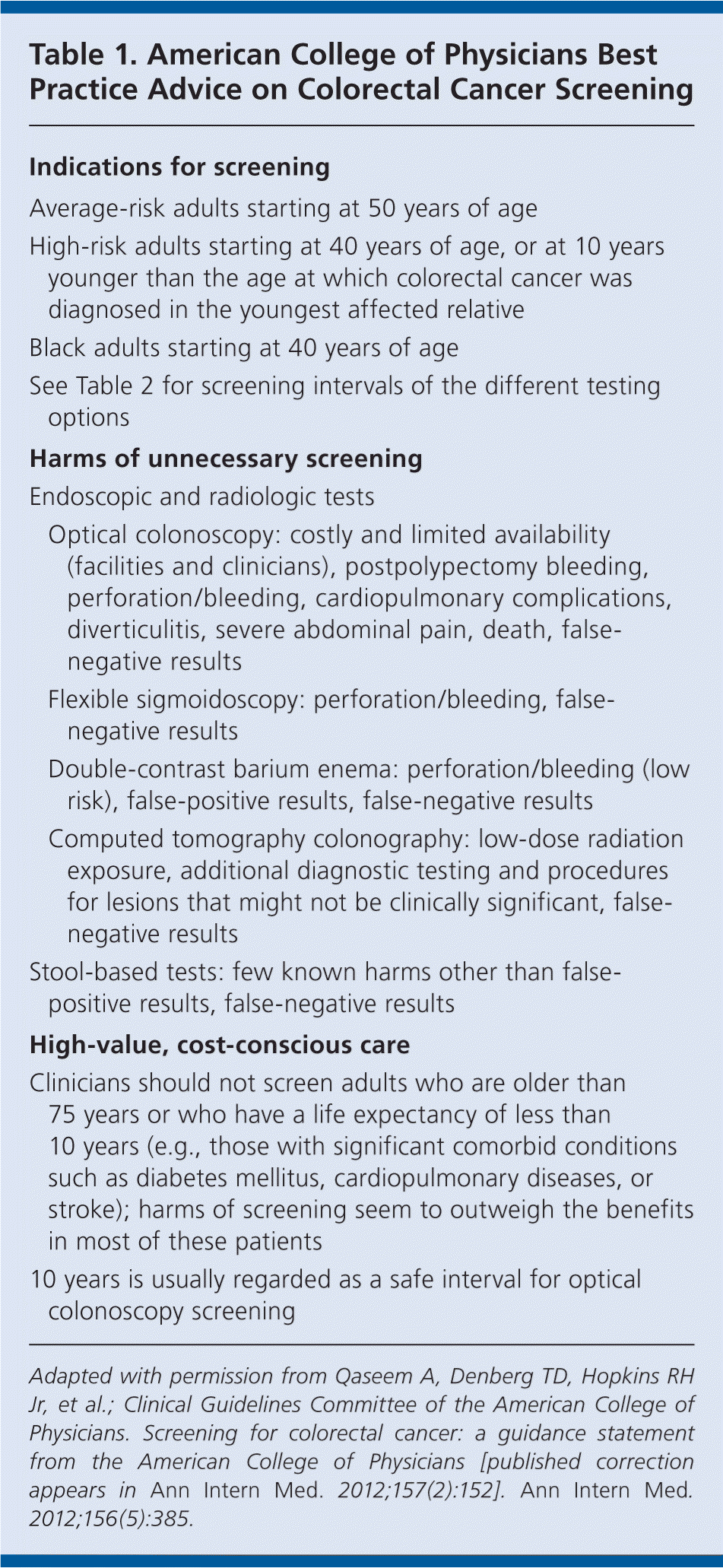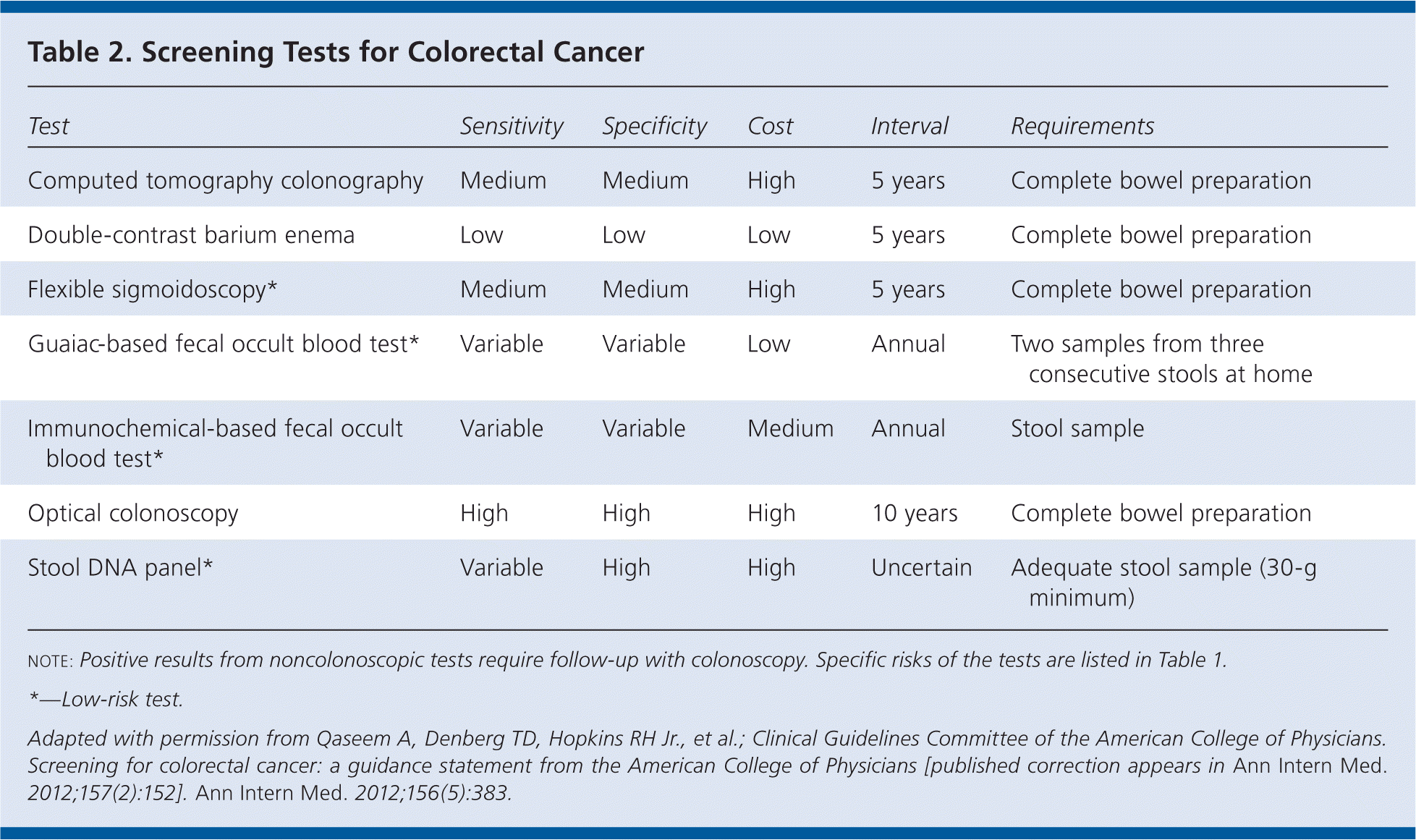
Am Fam Physician. 2012;86(12):1153-1154
Guideline source: American College of Physicians
Evidence rating system used? Yes
Literature search described? Yes
Guideline developed by participants without relevant financial ties to industry? Yes
Published source: Annals of Internal Medicine, March 6, 2012
Available at: http://annals.org/article.aspx?volume=156&page=378
Although the incidence of colorectal cancer in the United States has been declining by 2 to 3 percent per year over the past 15 years, it is the second leading cause of cancer-related death in the country. The disease is rare before 40 years of age, with 90 percent of cases occurring in those older than 50 years. Appropriate screening is important because detection and removal of premalignant adenomas or localized cancer can prevent the development of cancer.
The American College of Physicians (ACP) recently reviewed available guidelines from the American Cancer Society/U.S. Multi-Society Task Force on Colorectal Cancer/American College of Radiology, Institute for Clinical Systems Improvement, U.S. Preventive Services Task Force, and the American College of Radiology. Based on the evidence from these guidelines, the ACP has published best practice advice, which is summarized in Table 1.

| Indications for screening | |
| Average-risk adults starting at 50 years of age | |
| High-risk adults starting at 40 years of age, or at 10 years younger than the age at which colorectal cancer was diagnosed in the youngest affected relative | |
| Black adults starting at 40 years of age | |
| See Table 2 for screening intervals of the different testing options | |
| Harms of unnecessary screening | |
| Endoscopic and radiologic tests | |
| Optical colonoscopy: costly and limited availability (facilities and clinicians), postpolypectomy bleeding, perforation/bleeding, cardiopulmonary complications, diverticulitis, severe abdominal pain, death, false-negative results | |
| Flexible sigmoidoscopy: perforation/bleeding, false-negative results | |
| Double-contrast barium enema: perforation/bleeding (low risk), false-positive results, false-negative results | |
| Computed tomography colonography: low-dose radiation exposure, additional diagnostic testing and procedures for lesions that might not be clinically significant, false- negative results | |
| Stool-based tests: few known harms other than false-positive results, false-negative results | |
| High-value, cost-conscious care | |
| Clinicians should not screen adults who are older than 75 years or who have a life expectancy of less than 10 years (e.g., those with significant comorbid conditions such as diabetes mellitus, cardiopulmonary diseases, or stroke); harms of screening seem to outweigh the benefits in most of these patients | |
| 10 years is usually regarded as a safe interval for optical colonoscopy screening | |
Guidance Statements
Clinicians should perform individualized assessment of risk for colorectal cancer in adults.
This assessment can help determine when screening should begin. Risks include age, race, and family history (e.g., history of colorectal cancer, especially in a first-degree relative diagnosed before 50 years of age; hereditary nonpolyposis; or familial adenomatous polyposis). Blacks have the highest incidence of cancer compared with other races.
Clinicians should screen for colorectal cancer in average-risk adults starting at 50 years of age, and in high-risk adults at 40 years of age or at 10 years younger than the age at which colorectal cancer was diagnosed in the youngest affected relative.
Evidence shows that screening identifies premalignant lesions, allowing for early treatment and reduced mortality. The benefits of screening outweigh the risks in these adults.
Stool-based tests, flexible sigmoidoscopy, or optical colonoscopy should be used for screening average-risk adults. Test selection should be based on benefits versus harms, availability, and patient preference.
Because colorectal cancer screening tests have similar effectiveness, the patient should be counseled about the benefits, harms, effectiveness data, and costs of the different options (Table 2). Optical colonoscopy is generally considered the preferred screening test; however, it has a false-negative rate of 10 to 20 percent, and evidence on the optimal frequency of the screening is unclear. Although colonoscopy screening every 10 years is regarded as safe in average-risk persons, high-risk persons should be screened every five years. If a noncolonoscopic test is used, patients with a positive result should receive follow-up colonoscopy screening. Although computed tomography colonography is an option for average-risk patients older than 50 years, the U.S. Preventive Services Task Force found insufficient evidence to determine the benefits and harms of the test.

| Test | Sensitivity | Specificity | Cost | Interval | Requirements |
|---|---|---|---|---|---|
| Computed tomography colonography | Medium | Medium | High | 5 years | Complete bowel preparation |
| Double-contrast barium enema | Low | Low | Low | 5 years | Complete bowel preparation |
| Flexible sigmoidoscopy* | Medium | Medium | High | 5 years | Complete bowel preparation |
| Guaiac-based fecal occult blood test* | Variable | Variable | Low | Annual | Two samples from three consecutive stools at home |
| Immunochemical-based fecal occult blood test* | Variable | Variable | Medium | Annual | Stool sample |
| Optical colonoscopy | High | High | High | 10 years | Complete bowel preparation |
| Stool DNA panel* | Variable | High | High | Uncertain | Adequate stool sample (30-g minimum) |
Screening should end after 75 years of age or if the patient's life expectancy is less than 10 years.
The harms of screening seem to outweigh the benefits in these patients.
